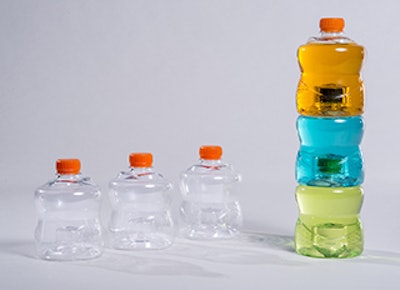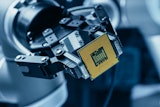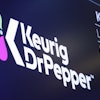
Packaging must be individually designed, promise product quality and possibly offer extra utility as well.
“As real as knowing where you belong” — with this slogan of the Brinkhoff’s No. 1 beer brand from the Ruhr district in Germany, the Dortmund Brinkhoff’s brewery is targeting the people in the area. On the labels of the special edition, the company is showing 40 sights from 21 Ruhr district towns in Germany with a description of the pictured site on the reverse of the peelable labels.
Local patriotism and beer-drinking — a sure source of sales. “Our edition is really popular,” says Brinkhoff’s Marketing Manager Andreas Thielemann.
Successfully selling a product requires that it stand out. This applies particularly to the competitive beverage market. The times when mineral water, beer and schnapps were sold in standard bottles are long gone. Thanks to the rise of alcoholic mixed drinks and aromatized soft drinks, beverage diversity has become almost overwhelming. Without professional brand building, spring owners and breweries no longer stand a chance in this highly competitive market.
“The general goal is to create a visual vocabulary that can be seen, felt and understood within five seconds or less,” explains brand expert Terri Goldstein of The Goldstein Group, a U.S. marketing company. While Brinkhoff’s chooses a relatively low-key vocabulary for its home-region labels, other beverage manufacturers are taking more elaborate measures by embossing brand names in the bottles and using colors and memorable motifs so that no two bottles are the same. Individualization is a trend becoming more popular in the beverage sector.
A bottle for every occasion
One of the pioneers of this trend is the Swedish company, Absolut Vodka. In 2012, the company launched its Absolut Unique series, a limited edition of 4 million glass bottles that are, above all, two things: colorful and unique. No two bottles are alike. To enhance this effect, each bottle bears its own number — like limited prints of a work of art.
The trend towards uniqueness can also be observed with multi-way bottles. Every major beverage manufacturer today uses individualized containers in order to appeal more directly to target groups. Sinalco, for example, has introduced a 0.5-liter, multi-way bottle for its lemonades so that it can access smaller households as well. Staatl. Fachingen in Hesse, Germany markets its mineral water in special faceted bottles that it sells in three different sizes exclusively to restaurants.
Although individual beverage packaging generates higher sales, it has its drawbacks. Elaborately designed bottles drive up development and production costs and burden the environment. To counteract excess waste in cities and rural areas, countries like Germany have set goals to raise the recycling rates in the beverage packaging sector. However, the growing share of individualized multi-way bottles has the opposite effect: return rates are falling, transport distances from the bottler to the consumer are growing and the life-cycle assessment of multi-way bottles is deteriorating. All the same, individual bottles are often lighter than comparable standard multi-way bottles, which offsets this effect to some extent. Nevertheless, the growing diversity of bottles is increasing the complexity of sorting and pushing up costs.
More and more beverage manufacturers are reverting to one-way plastic bottles and cans. In Germany, the “Bund Getränkeverpackungen der Zukunft” was founded last year to advocate a renaissance of one-way bottles and cans. Its lobbying has evidently been successful since, according to information from the Nature and Biodiversity Conservation Union (NABU) in Germany, the one-way packaging rate in Germany has already reached 50 percent, and the figure continues to rise.
Benjamin Bongardt, Head of Resource Policy at NABU, is concerned. “The environment only benefits when we choose the right beverage packaging solution and make it increasingly efficient. A single multi-way bottle replaces up to 50 one-way bottles — and is additionally recycled at the end of its life. One-way is therefore synonymous with active resource wastage,” he says.
Packaging manufacturers are, therefore, faced with major challenges. How can they manufacture containers that are even more attractive and consumer-friendly? And how can they conserve resources and go easy on the environment at the same time?
The performance profiles of packaging machinery are also becoming more exacting. “We have to think about how bottlers can boost the energy efficiency and eco-friendliness of product packaging at a lower cost,” says Product Manager, Jochen Forsthövel of the German filling technology and packaging machine manufacturer Krones.
At the interpack 2014 trade fair in Düsseldorf, Germany from May 8-14, 2014, visitors can see for themselves the strategies and products companies are using to address the needs of the market. interpack promises an abundance of exciting impressions, as packaging specialists are working hard to innovate and cut costs.
Saving materials on a broad front
One of the main focuses at Krones is to develop PET bottles and cut down on valuable material. The company’s new 0.5-liter “PET lite 9.9 carbonated” bottle weighs only 9.9 grams (0.35 ounces) — about a third less than conventional PET bottles of this size. The container’s special design nevertheless ensures it stands firm and can be safely transported. Krones is also innovating PET bottles that can be filled with hot liquids, e.g. fruit juice. These bottles usually have to have a stronger design, as they readily shrink with exposure to heat. Krones’ novel NitroHotfill process keeps containers stable during filling by raising the internal pressure with nitrogen. “We can thus achieve weight savings in both the bottle body and mouthpiece,” explains Product Manager Jochen Forsthövel.
French manufacturer BTC Concepts is showing the direction plastic bottle development may soon be taking. By screwing three individual bottles together to create a single large one, the Parisian company has created a three-in-one container with an innovative design that sets it apart from other bottles. The BottleClips concept also conserves resources, as the bottles save storage space and fuel during transport. The consumer will waste less product, as the three bottles are opened one after the other.
Cost-cutting innovation can be found not only in bottle design, production and filling, but also in downstream labeling. Krones’ new DecoType direct printing system is capable of embellishing uneven surfaces with a digital inkjet process, so there is no need for a special label and the associated adhesives materials. But this does not mean the end of classical labeling. Here, too, there is huge innovation potential, as the Italian specialist PD Labellers is demonstrating with its new Adhesleeve rotary labeling machine. To save energy, the machine operates with acrylic adhesive to bond the labels instead of a hot-melt adhesive. PE Labellers also claims that Adhesleeve is capable of using labels 30 percent thinner than conventional ones.
The Dortmund KHS company sees itself as the “First Choice in Technology and Service” in beverage packaging. At interpack 2014, the specialist in packaging solutions and filling technology is presenting its new KHS INNOPACK Kisters TSP A-H-TPFO packaging machine, which it claims is particularly versatile in its use, cuts costs in production and sets new standards of sustainability. “The machine is modular and thus also equipped for future needs and customer wishes,” explains KHS expert Frederike Arndt.
The machine, thanks to a special device, recently has become capable of packaging PET bottles in fully enclosed packages. The advantage of this is that these packages are stronger than current conventional shrink packs, ousting extra cardboard trays for stability and reducing the input of materials. The wrap-around shrink packing process for packages in the new KHS INNOPACK can also be performed in a shrink tunnel with either electric or gas heating.
“Energy costs can thus be reduced by up to 50 percent over conventional electric heating,” states Frederike Arndt. There is also an energy-saving package that can be optionally integrated in any shrink tunnel variant. Here, a roller shutter system automatically closes the opening for product inlet and outlet during packaging machine stoppages to facilitate extra energy savings of up to 20 percent.
For more food industry news and information, subscribe here and follow us on Twitter, Facebook or LinkedIn.























